Table of contents:
Disability and the 2030 Agenda for Sustainable Development
Reaffirming the universality, indivisibility, interdependence and interrelatedness of all human rights and fundamental freedoms and the need for persons with disabilities to be guaranteed their full enjoyment without discrimination... Emphasizing the importance of mainstreaming disability issues as an integral part of relevant strategies of sustainable development... Recognizing the valued existing and potential contributions made by persons with disabilities to the overall well-being and diversity of their communities.
Preamble to the Convention on the Rights of Persons with Disabilities.
The SDGs and targets are integrated and indivisible, global in nature and universally applicable.
The 2030 Agenda for Sustainable Development.
The 2030 Agenda for Sustainable Development was adopted by the UN General Assembly on 25 September 2015. Consisting of the 17 Sustainable Development Goals (SDGs) and 169 targets, the Agenda covers a broad array of issues including poverty, hunger, education, and health, as well as climate change, clean energy, and responsible consumption and production. It entails comprehensive aspirations and transformative commitments towards making societies more inclusive and ensuring that everyone will be able to realize their human potential in dignity and equality. Persons with disabilities are mentioned three times in the declaration and are explicitly referred to in seven of the SDG targets. In addition, numerous references to population categories such as “those in vulnerable situations” are understood as encompassing persons with disabilities.
In order to guide decision making and for the purpose of reviewing what progress is being made towards realizing the SDGs and targets, 232 global indicators have been developed.
14 of these make direct reference to persons with disabilities or are attached to targets that do. For example, indicator 8.5.2 says that progress towards meeting target 8.5, relating to decent work for everyone, should be reviewed taking into account “ unemployment rate, by sex, age and persons with disabilities”. In addition, Member States are expected to develop regional, national, and sub-national indicators, in large part to be based on the global ones.[1]
These specific references imply considerable progress as compared to the eight Millennium Development Goals, which were adopted in 2000 and preceded the SDGs, since those did not include any specific references to persons with disabilities. The fact that persons with disabilities are directly mentioned in the 2030 Agenda and in the global indicators makes it likely that they will be included more explicitly in the implementation plans developed by states and other actors, and that any failure to include them will be detected.
| Goal | Target | Indicator |
|---|---|---|
| 1 End poverty in all its forms everywhere | 1.3 Implement nationally appropriate social protection systems and measures for all, including floors, and by 2030 achieve substantial coverage of the poor and the vulnerable | 1.3.1 Proportion of population covered by social protection floors/systems, by sex, distinguishing children, unemployed persons, older persons, persons with disabilities, pregnant women, newborns, work injury victims and the poor and the vulnerable |
| 4 Ensure inclusive and equitable quality education and promote lifelong learning opportunities for all |
4.5 By 2030, eliminate gender disparities in education and ensure equal access to all levels of education and vocational training for the vulnerable, including persons with disabilities, indigenous peoples and children in vulnerable situations | 4.5.1 Parity indices (female/male, rural/urban, bottom/top wealth quintile and others such as disability status, indigenous peoples and conflict affected, as data become available) for all education indicators on this list that can be disaggregated |
| 4.a Build and upgrade education facilities that are child, disability and gender sensitive and provide safe, non-violent, inclusive and effective learning environments for all | 4.a.1 Proportion of schools with access to: (a) electricity; (b) the Internet for pedagogical purposes; (c) computers for pedagogical purposes; (d) adapted infrastructure and materials for students with disabilities; (e) basic drinking water; (f) single sex basic sanitation facilities; and (g) basic handwashing facilities (as per the WASH indicator definitions) | |
| 8 Promote sustained, inclusive and sustainable economic growth, full and productive employment and decent work for all |
8.5 By 2030, achieve full and productive employment and decent work for all women and men, including for young people and persons with disabilities, and equal pay for work of equal value |
8.5.1 Average hourly earnings of female and male employees, by occupation, age and persons with disabilities 8.5.2 Unemployment rate, by sex, age and persons with disabilities |
| 10 Reduce inequality within and among countries | 10.2 By 2030, empower and promote the social, economic and political inclusion of all, irrespective of age, sex, disability, race, ethnicity, origin, religion or economic or other status | 10.2.1 Proportion of people living below 50 per cent of median income, by sex, age and persons with disabilities |
| 11 Make cities and human settlements inclusive, safe, resilient and sustainable | 11.2 By 2030, provide access to safe, affordable, accessible and sustainable transport systems for all, improving road safety, notably by expanding public transport, with special attention to the needs of those in vulnerable situations, women, children, persons with disabilities and older persons | 11.2.1 Proportion of population that has convenient access to public transport, by sex, age and persons with disabilities |
| 11.7 By 2030, provide universal access to safe, inclusive and accessible, green and public spaces, in particular for women and children, older persons and persons with disabilities |
11.7.1 Average share of the built-up area of cities that is open space for public use for all, by sex, age and persons with disabilities 11.7.2 Proportion of persons victim of physical or sexual harassment, by sex, age, disability status and place of occurrence, in the previous 12 months |
|
| 16 Promote peaceful and inclusive societies for sustainable development, provide access to justice for all and build effective, accountable and inclusive institutions at all levels | 16.7 Ensure responsive, inclusive, participatory and representative decision-making at all levels |
16.7.1 Proportions of positions (by sex, age, persons with disabilities and population groups) in public institutions (national and local legislatures, public service, and judiciary) compared to national distributions 16.7.2 Proportion of population who believe decision making is inclusive and responsive, by sex, age, disability and population group |
| 17 Strengthen the means of implementation and revitalize the Global Partnership for Sustainable Development | 17.18 By 2020, enhance capacity-building support to developing countries, including for least developed countries and small island developing States, to increase significantly the availability of high-quality, timely and reliable data disaggregated by income, gender, age, race, ethnicity, migratory status, disability, geographic location and other characteristics relevant in national contexts |
17.18.1 Proportion of sustainable development indicators produced at the national level with full disaggregation when relevant to the target, in accordance with the Fundamental Principles of Official Statistics 17.18.2 Number of countries that have national statistical legislation that complies with the Fundamental Principles of Official Statistics 17.18.3 Number of countries with a national statistical plan that is fully funded and under implementation, by source of funding |
At the same time, however, it is critical to remember that all SDGs and targets, being “global in nature and universally applicable”, apply to persons with disabilities just as much as to anyone else: the fact that persons with disabilities are directly mentioned in seven targets does not mean that the other 162 do not concern them. This understanding is consonant with the overall intent of the 2030 Agenda itself. As noted above, the preamble of the SDGs confirms that the goals are universal, i.e. applying to everyone without exception. It also emanates from target 17.18, which calls for increasing the quantity and accuracy of data that is disaggregated by disability among other parameters.
Furthermore, the interpretation of the 2030 Agenda as applicable in its entirety to persons with disabilities is supported by the CRPD. The Convention not only reaffirms the universal nature of human rights and the inadmissibility of discrimination, but also directly calls for disability rights to be mainstreamed in development strategies.
Though the SDGs and targets are aspirational in character, considerable overlaps in content between them and the CRPD give the 2030 Agenda a certain legally binding character. For instance, SDGs 3 and 4, relating to health and education, correspond to CRPD Articles 24 and 25. This means that parties to the CRPD are in fact required by international law to pursue many of the SDGs and targets in a way which does not exclude persons with disabilities. Thus, implementing Agenda 2030 in a disability inclusive fashion will effectively serve to honour the provisions of the CRPD, and the indicators developed to measure progress with regard to the SDGs and targets can be used to monitor compliance with the CRPD.
The SDGs and targets are highly interdependent. Similarly, the stipulations of the CRPD are in large part contingent upon each other. That is recognized in the respective preambles of the 2030 Agenda and the CRPD: the former notes that all SDGs and targets are “integrated and indivisible”, and the latter reaffirms the “interdependence and interrelatedness of all human rights and fundamental freedoms”. Thus, no SDG or target, and no CRPD provision, can be realized in isolation. This is true not only on a general plane, but also with regard to the inclusion of persons with disabilities. In other words, ensuring the inclusion of persons with disabilities in the implementation of one SDG or target, or in one CRPD provision, requires the same being done in the implementation of others.
Figure 1 illustrates this by concentrating on four essential components of development incorporated in the 2030 Agenda as well as in the CRPD (and, it should be noted, in other human rights treaties). Decent work, the topic of SDG target 8.5 and of CRPD Article 27, will not be possible to achieve for persons with disabilities unless they are granted access to quality education, the subject of SDG 4 and of CRPD Article 24. Meanwhile, employment and education are conditional upon a high standard of health, the theme of SDG 3 and CRPD Article 25, since poor health status often poses an obstacle to partaking in the workforce or to the pursuit of education. At the same time, these three objectives are all contingent upon the existence of accessible means of transport, an objective specifically included in SDG target 11.2 and CRPD Article 9, since workplaces, schools and health centres will otherwise be hard to reach for persons with disabilities.[2] Of course, each of the four areas illuminated in the figure can in turn be connected to other ones in the 2030 Agenda and in the CRPD.
The 2030 Agenda, which is based on the notion of “leaving no one behind”, will fall short if persons with disabilities are excluded. Meanwhile, ensuring their inclusion will make it easier to realize the whole agenda for everyone.
For instance, the fact that persons with disabilities frequently do not have access to adequate health care[3] does not merely imply that their basic social and economic human rights are left unfulfilled: it also entails an avoidable loss for their societies, since improved health status would render it possible for more persons with disabilities to study, work and contribute to social cohesion, growth and prosperity. Notably, this acknowledgement of “the valued existing and potential contributions made by persons with disabilities to the overall well-being and diversity of their communities”[4] is a tenet of the CRPD.
Monitoring progress towards meeting the commitments of Agenda 2030 and the CRPD is an ongoing challenge for statistical offices around the world. The global framework of indicators has only recently been adopted,[5] and the metadata for a number of them have yet to be developed. This includes some 14 indicators that have been identified as a priority for exploring the situation of persons with disabilities, as mentioned above. Despite remarkable progress, the need to develop more comprehensive disability data in Arab countries is reflected by the gaps in the most recent statistics, collected by the ESCWA Statistical Division.[6] The remainder of this chapter provides a brief snapshot of those statistics, as well as some additional data, as currently available.
The statistics collected by ESCWA indicate that persons with disabilities, defined in line with the recommendations of the Washington Group (see above), make up between 0.2 and 5.1 per cent of the total populations in those Arab countries for which data is available.
The sharp differences across countries in terms of overall prevalence, the comparatively low overall prevalence rates in some countries as compared to in the rest of the world,[7] as well as the fact that in most countries the disability rate is somewhat lower among women than among men, warrant explanation. This is not completely available at this point and requires deeper research.[8] However, in all Arab countries, as shown in figure 3, the disability prevalence rate is considerably higher among the elderly than among the population at large. Thus, the fact that overall disability prevalence differs within the region may in part be due to the fact that some countries have older populations.
Figure 1. Interlinkages of CRPD and 2030 Agenda components
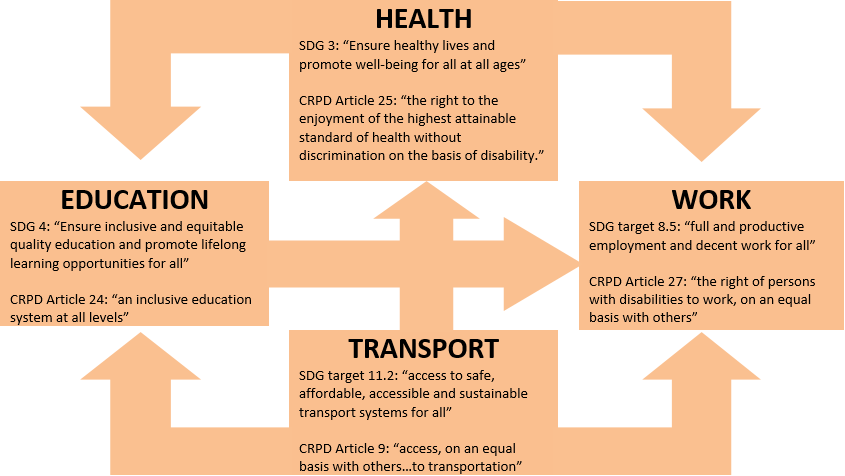
Figure 2. Total disability prevalence rates by gender (percentage), selected countries, different years
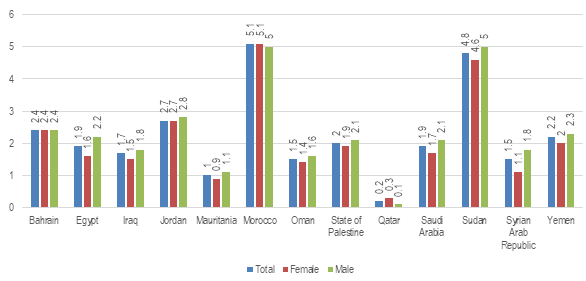
Source: calculated from ESCWA, 2017d, based on data provided by NSOs from the: Bahrain, Census 2010; Egypt, Labour Force Survey, 2016; Iraq, I-PMM 2013; Jordan, Census 2015; Mauritania, Census 2013; Morocco, Census 2014; Oman, Census 2010; State of Palestine, Census 2007; Qatar, Census 2010; Saudi Arabia, DHS 2016; Sudan, Census 2008; Syrian Arab Republic, Budget Survey 2007; and Yemen, Household Budget Survey 2014.
Figure 3. Total disability prevalence rates and rates for people aged 65+, 2007-2016 (percentage)
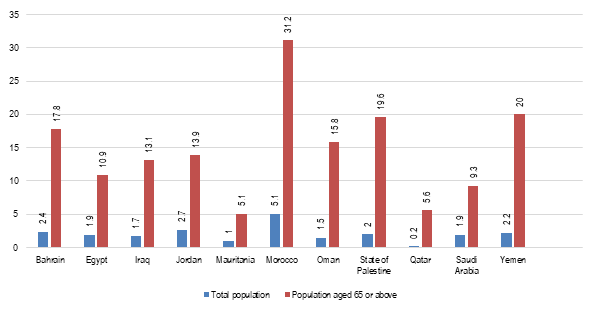
Source: calculated from ESCWA, 2017d, based on data provided by NSOs from the: Bahrain, Census 2010; Egypt, Labour Force Survey, 2016; Iraq, I-PMM 2013; Jordan, Census 2015; Mauritania, Census 2013; Morocco, Census 2014; Oman, Census 2010; State of Palestine, Census 2007; Qatar, Census 2010; Saudi Arabia, DHS 2016; and Yemen, Household Budget Survey 2014.
As shown by figure, persons aged above 65 years generally constitute a larger proportion of the total population in countries with relatively high disability prevalence rates. For example, in Morocco, the country with the highest disability prevalence rate (5.1 per cent), persons aged 65 or older make up 6.1 per cent of the total population, whereas in Qatar, the country with the lowest disability prevalence rate (0.2 per cent), persons aged 65 or older constitute merely 0.8 per cent of the total population.
The low prevalence rates could also be a consequence of the social stigma still attached to disability, since that may result in underreporting. This might also in part lie behind the comparatively low female rates, since there are indications that the stigma is stronger with regard to women and girls. Data collection methods which imply interviewing only the head of the household, instead of each household individual separately, may result in disability not being reported. In addition, persons with disabilities living in institutions – including disability institutions, care institutions for elderly people, as well as prisoners - are only counted in censuses and surveys if households report them as family members living outside of the house.[9]
Figure 4. Total disability prevalence rates and persons aged 65+ as percentage of total population, 2007-2016
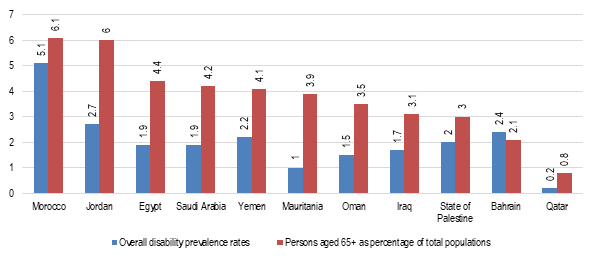
Source: calculated from ESCWA, 2017d (see figure 3).
Goal 1: no poverty
A major data gap relates to poverty, one of the key indicators of the new development agenda. Little data directly related to poverty among persons with disabilities as compared to persons without disabilities is yet available. One of few countries for which such data has been produced is Mauritania: according to its 2014 Poverty Profile, the disability prevalence rate among the poorest quintile of the population was almost four times higher than among the richest quintile. Meanwhile, households that included at least one person with a disability were more than twice as likely to be poor than those who did not.[10]
Surveys undertaken by Handicap International in areas of Morocco, Algeria and Tunisia seem to confirm that persons with disabilities’ income is very low: in Tunisia, 59.3 per cent reported not having any individual income, and 16.7
per cent stated that their individual income was lower than 150 dinars (approximately $76) per month.[11]
Goal 4: quality education
High poverty rates among persons with disabilities are partly due to their limited access to education. In the Arab region, the educational attainment of persons with disabilities is considerably lower than that of persons without disabilities, and it is particularly low among women with disabilities and persons with disabilities in rural areas. Figure 5 shows the proportion of persons with and without disabilities in Iraq with no educational attainment, disaggregated by sex and residence. While 41 per cent of Iraqis without disabilities lack education, 70.1 per cent of those with disabilities do. Furthermore, 81.8 per cent of women with disabilities have no educational attainment.
Figure 5. Persons aged 10+ with and without disabilities with no educational attainment, Iraq, 2013 (percentage)
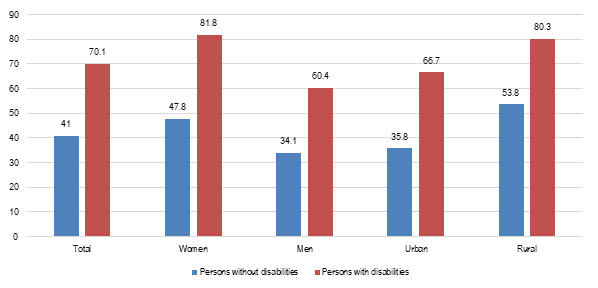
Source: calculated from ESCWA, 2017d, based on data from the I-PMM 2013.
Figure 6. Disability prevalence rate among children aged 0-4, 2007-2016 (percentage)
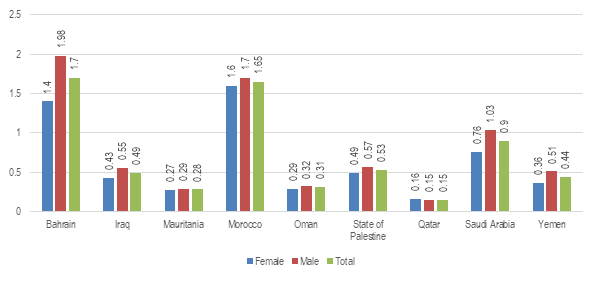
Source: calculated from ESCWA, 2017d, based on data provided by NSOs from the: Bahrain, Census 2010; Iraq, I-PMM 2013; Mauritania, Census 2013; Morocco, Census 2014; Oman, Census 2010; State of Palestine, Census 2007; Qatar, Census 2010; Saudi Arabia, DHS 2016; and Yemen, Household Budget Survey 2014.
Target 4.2 refers to early childhood development, and specifically indicator 4.2.1 aims to identify the “proportion of children under five years of age who are developmentally on track in health, learning and psychosocial well-being”, disaggregated by sex. This is an important value to be followed in the future, as it relates to early detection and intervention aiming to identify and prevent disability among small children.
At present data on this indicator is not available. Figure 6 shows the disability prevalence among children up and including the age of four years.
Goal 8: decent work
The employment rate is considerably lower among persons with disabilities than among those without (see figure 7). The data confirm comparatively low employment rates in Arab countries, especially among women, and indicate that women with disabilities are a particularly excluded group.
Figure 7. Employment rate among persons with and without disabilities aged 15-64 (percentage)
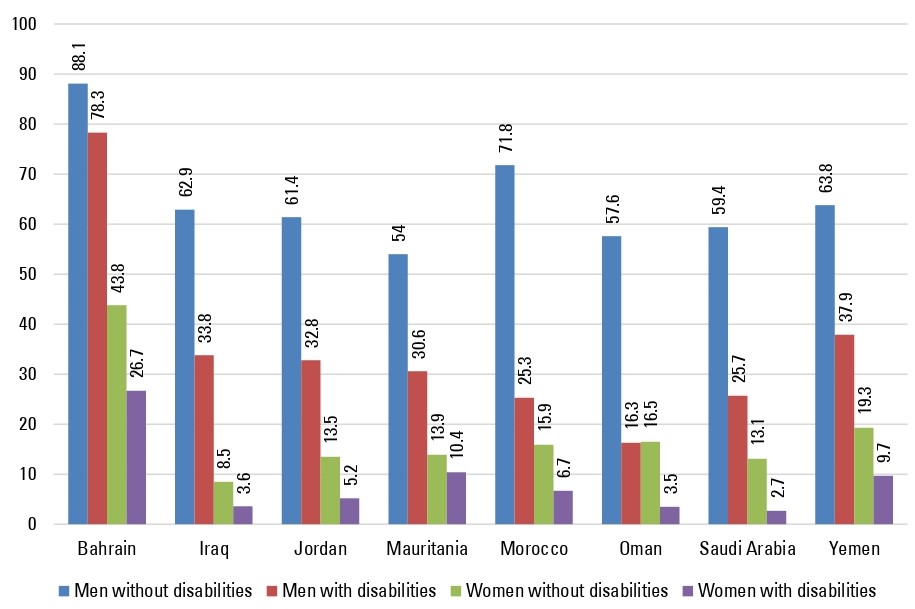
Source: calculated from ESCWA, 2017d, based on data provided by NSOs from the: Bahrain, Census 2010; Iraq, I-PMM 2013; Jordan, Census 2015; Mauritania, Census 2013; Morocco, Census 2014; Oman, Census 2010; Saudi Arabia, DHS 2016; and Yemen, Household Budget Survey 2014.
Figure 8. Economic inactivity, unemployment and employment (percentage) among men and women with and without disabilities aged 15-64, Saudi Arabia, 2016
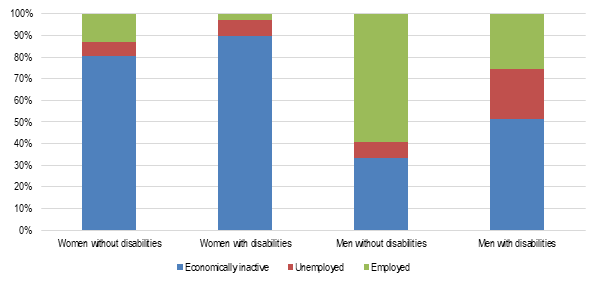
Source: calculated from ESCWA, 2017d, based on data from the Saudi Arabia DHS 2016.
The low employment rate among persons with disabilities is due to their disproportionately high rates of economic inactivity as well as of unemployment. This is illustrated in figure 8, which focuses on the example of Saudi Arabia. While economic inactivity there is as high as 80 per cent among women without disabilities, it is almost ten percentage points higher among women with disabilities. Among men with disabilities, economic inactivity is almost 20 percentage points higher than among men without disabilities, reaching 51.5 per cent. Unemployment, notably, is more than three times higher among men with disabilities than among men without disabilities. Relatively generous survivors’ benefits in the social insurance schemes may support the high rates of inactivity among persons with disabilities.
No data is available on average hourly earnings as requested by SDG indicator 8.5.1.
Goal 11: sustainable cities and communities
Accessing the built environment (homes, buildings and public spaces) presents a common challenge to persons with disabilities. SDG target 11.7 calls for open access to public spaces, though few countries have data available. In the State of Palestine, 85.3 per cent of people with mobility disabilities have reported some or a lot of difficulty getting around outdoors in their local area.[12] With regard to accessible transport, the subject of SDG indicator 11.2.1, 76.4 per cent of Palestinians with disabilities “do not use public transportation due to absence of necessary adaptation in the infrastructure”.[13] A survey carried out by the Moroccan Ministry of Family, Solidarity, Equality and Social Development indicated that 37.7 per cent of persons with disabilities in the country were unable to access public transport, and that 36.6 per cent could access it only with difficulty.[14]
Goal 5: gender equality
Increasing the visibility of women and girls and their position in development in general is one of the objectives of the Agenda 2030 in its entirety. The preceding discussion of selected SDG indicators clearly reflects the weaker position of women in general and of women with disabilities in particular, and thus confirms previous findings.[15] Official statistics show lower overall prevalence rates for women and girls, but they are evidently more disadvantaged in education and employment. The double discrimination often faced by females with disabilities not only limits girls’ development perspectives, but may also deprive elderly,
often widowed or unmarried, women of necessary support.[16]
Goal 17: partnership for the goals
Goal 17 details the support and partnership that is required for achieving the 2030 Agenda and the SDGs in areas such as finance, technology, capacity building and data collection, which are highly relevant to persons with disabilities. In particular, technological development can further their autonomy and social inclusion. Assistive technologies such as screen readers for persons with visual impairments and caption services for those with hearing impairments can accommodate workplaces to the needs of persons with disabilities. Other technologies, such as specific web applications, can assist persons with mobility impairment to search for accessible restaurants, cinemas and transport in their cities. Specific research related to technology solutions for persons with disabilities is still in its infancy, although progress is being made in the region, as exemplified later in this report.
Figure 9. Primary education attainment (percentage) in urban areas among females aged 10+ with and without disabilities, 2007-2013
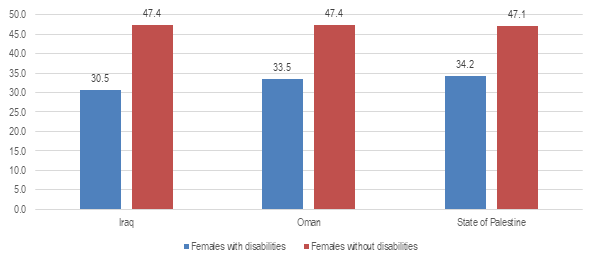
Source: calculated from ESCWA, 2017d, based on data from the: Iraq, I-PMM 2013; Oman, Census 2010; and State of Palestine, Census 2007.
Figure 10. Primary education attainment (percentage) in rural areas among females aged 10+ with and without disabilities, 2007-2013
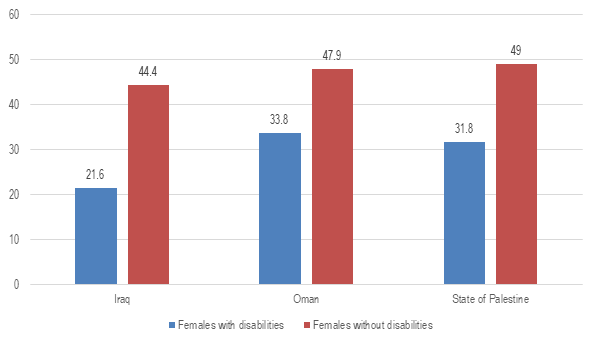
Source: see figure 9.
Several indicators of Goal 17 relate directly to the situation of and research on social protection for persons with disabilities in the Arab world. Target 17.18 entails accurate data collection, particularly in developing States, disaggregated by gender, migratory status, disability and other relevant factors. Such disaggregation will allow for a better understanding of, for example, the multiple disadvantages often faced by women and children with disabilities in rural areas.
One example of such multiple disadvantage is presented in figure 9 and 10, which shows that rural girls with disabilities are disadvantaged in primary education not only in comparison to girls without disabilities, but also in comparison to their peers in urban areas.
The need for timely and reliable data collection becomes more apparent throughout the report, specifically related to prevalence rates, labour force status, and coverage of social protection schemes in the Arab world. For example, statistical information about target 1.3 and indicator 1.3.1, relating to the “proportion of population covered by social protection floors/systems”, disaggregated for disability status, did not become available through the recent ESCWA data collection. In order to progress towards the social inclusion of persons with disabilities, and to break the vicious circle of exclusion and poverty, social protection has a key role to play. Being part both of the 2030 Agenda and of the CRPD, social protection needs to be an integrated component of the wider development effort.
This report thus approaches the question from the policy side, laying out the social protection systems, and refers information about coverage as available. It also lays out policies to ensure access of persons with disabilities to health care as a component of the social protection floor, which also relates to SDG goal 3, target 3.8, aiming at universal health coverage. It will show that Arab countries have made substantive progress towards this end, but that much work nevertheless remains to be done.
[1] United Nations Statistical Commission, 2016, p. 7.
[2] Bearing in mind that the 2030 Agenda as a whole applies to persons with disabilities, accessible transport can also be coupled to SDG 9, which inter alia concerns resilient infrastructure.
[3] World Health Organization and World Bank, 2011, chap. 3.
[4] CRPD preamble.
[5] United Nations Statistical Commission, 2017.
[6] ESCWA, 2017d.
[7] The 2011 World Disability Report, issued by the Word Bank and the WHO, estimated the global disability rate to 15.6 percent. However, it must be noted that this number is based on a broader definition of disability than that recommended by the WG, making it hard to compare outright with the numbers for the Arab region.
[8] As the current publication is mainly devoted to social protection of persons with disabilities as one of the priority aspects of the SDGs (target 1.3), this section only reflects some of the SDGs. A more complete data analysis will be available in the upcoming publication “Disability in the Arab Region 2018”.
[9] Information about the share of persons with disabilities living in disability institutions is currently not publicly available and is the subject of an ongoing ESCWA research project.
[10] Mauritania, Ministry of Economic Affairs and Development and National Statistics Office, 2015, pp. 63-64.
[11] Pinto, Pinto and Cunha, 2016a, p. 28. To set this in context, it may be noted that the official minimum wage for a person working 40 hours a week was in 2015 raised to 290 dinars – see Tunisia, 2015. The national poverty line and extreme poverty line were in the same year set to 1706 dinars and 1032 dinars per person and year, respectively corresponding to 142 dinars and 86 dinars per month - see Tunisia, National Institute of Statistics, 2016a. For the studies in Algeria and Morocco, see Pinto, Pinto and Cunha, 2016b, and 2016c.
[12] Palestinian Central Bureau of Statistics and Ministry of Social Affairs, 2011, p. 74.
[13] Ibid., p. 22.
[14] Morocco, Ministry of Family, Solidarity, Equality and Social Development, 2014, p. 59.
[15] Nagata, 2003, pp. 11-12.
[16] UN Women, n.d.